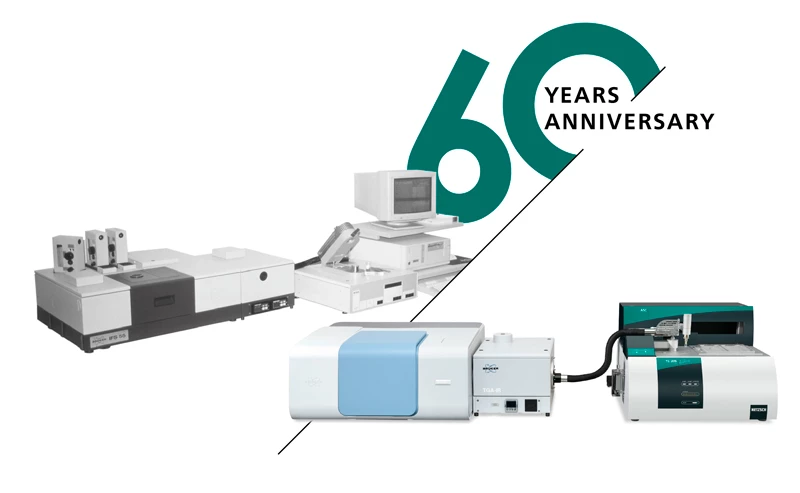
02.03.2022 by Erwin Kaisersberger
Systemy analizy gazów połączone z urządzeniami NETZSCH: Jak to się wszystko zaczęło
NETZSCH-Gerätebau GmbH to ponad pół wieku doświadczenia w rozwoju technologii sprzęgania. W miesiącu March dowiesz się w historycznym podsumowaniu, jak to wszystko się zaczęło, jakie systemy były używane wtedy i jakie są używane dzisiaj, a także przeczytasz ekscytujące wypowiedzi naszych wieloletnich klientów i partnerów.
NETZSCH-Gerätebau GmbH to ponad pół wieku doświadczenia w rozwoju technologii sprzęgania. W miesiącu March dowiesz się w historycznym podsumowaniu, jak to wszystko się zaczęło, jakie systemy były używane wtedy i jakie są używane dzisiaj, a także przeczytasz ekscytujące wypowiedzi naszych wieloletnich klientów i partnerów.
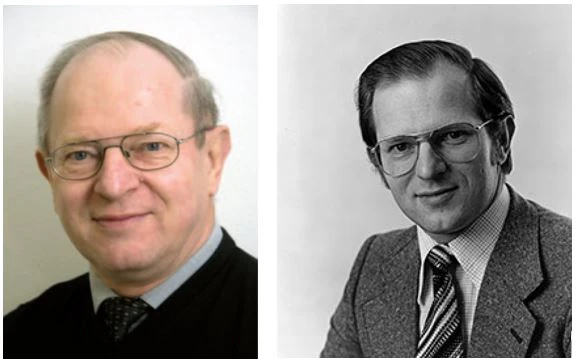
W 1973 roku fizyk Erwin Kaisersberger dołączył do NETZSCH i początkowo był odpowiedzialny za aplikacje i sprzedaż w Niemczech i za granicą. Kolejne etapy kariery obejmowały stanowisko kierownika Laboratorium Aplikacji, kierownika Działu Sprzedaży Technicznej oraz "Starszego Naukowca" w ogólnoświatowym Zespole Obsługi i Wsparcia Aplikacji. Począwszy od 2007 r. pracował dla firmy jako niezależny konsultant, zanim w 2012 r. przeszedł na zasłużoną emeryturę - po 39 latach pracy. W ciągu ostatnich pięciu lat całą swoją energię poświęcił w szczególności obszarowi sprzęgania TGA-GC-MS.
Erwin Kaisersberger opracował dla nas historię sprzęgania systemów analizy gazów z instrumentami NETZSCH:
Punkt początkowy w 1970 r
Jak widać z opisu historii STA w rocznicowym artykule z lutego 2022 r., pierwszy model NETZSCH STA o numerze 429 został zaprezentowany w 1970 roku. Miało to miejsce przy okazji Międzynarodowych Targów Inżynieryjnych w Brnie (jesień 1970 r.), które w tamtym czasie i jeszcze wiele lat później były ważnym rynkiem dla biznesu m.in. z krajami Europy Wschodniej.
Do 1970 r. NETZSCH faworyzował filozofię, że lepiej jest pracować oddzielnie z DTA i TGA, ponieważ w przypadku DTA szybsze szybkości ogrzewania były skuteczne w uzyskiwaniu pików larger; z drugiej strony, w przypadku TGA preferowane były wolniejsze szybkości ogrzewania w celu określenia zmian masy w stanie jak najbardziej zbliżonym do równowagi. Równoczesne zastosowanie DTA i TGA do pojedynczej próbki w identycznych warunkach zostało jednak szybko ustalone.
Wraz z wprowadzeniem STA 429, który od początku był zaprojektowany jako próżnio- i gazoszczelny, weszliśmy w nowy segment rynku i natychmiast zaczęliśmy konkurować z innymi producentami z Europy Zachodniej; miało to również miejsce w Europie Wschodniej w przypadku derywatografu (Paulik i Erdey). Szczególnie w wyższym zakresie temperatur, NETZSCH był w stanie wnieść swoje wieloletnie doświadczenie w dziedzinie substancji nieorganicznych, minerałów i ceramiki.
Jeszcze przed 1973 r. firma NETZSCH prowadziła szeroko zakrojony program produkcyjny, jak podano w broszurze dylatometru z 1973 r. (artykuł rocznicowy ze stycznia 2022 r.). Obejmował on również stale działające przyrządy do wykrywania gazu do sprzęgania z gazoszczelnymi modelami DTA, TGA, STA i dylatometrów. Oczywiście te detektory gazu, które rejestrowały zmiany przewodności cieplnej (EGA), gęstości gazu (EGD) lub radioaktywności (ETA) próbki gazu podczas eksperymentu, nie były całkiem satysfakcjonujące pomimo ich prostoty i faktu, że niektóre z nich miały wysoką czułość wykrywania: Pokazywały one jedynie, że gazy wyewoluowały lub zostały zaabsorbowane, ale nie które z nich!
Identyfikacja gazów była jednak w tamtym czasie tak samo aktualnym tematem jak dziś. Ale jakie systemy analizy gazów były początkowo dostępne? Prace rozwojowe szybko skupiły się na kwadrupolowym spektrometrze mas ze względu na jego kompaktowość i wysoką czułość detekcji (1960: Wynalezienie kwadrupolowego filtra masy przez niemieckiego fizyka i późniejszego laureata Nagrody Nobla, Wolfganga Paula, i jego współpracownika, Helmuta Steinwedela, na Uniwersytecie w Bonn).

Od 1970 r. rozwój przyrządów w NETZSCH był również ukierunkowany na bardziej kompaktowe wymiary z smaller, a tym samym szybszymi piecami, zmniejszonymi komorami próbek dla lepszego oczyszczania gazu i szczelności próżniowej w celu uzyskania czystej atmosfery gazowej na próbkach. Był to podstawowy wymóg dla sensownego połączenia czułych systemów analizy gazów. Począwszy od 1970 roku, elektronika opracowana przez Karla Bayreuthera i jego zespół w firmie NETZSCH została wykorzystana w systemach kontroli instrumentów. Dzięki temu przyrządy stały się bardziej elastyczne i precyzyjne, zwłaszcza w zakresie kontroli temperatury i akwizycji danych pomiarowych.
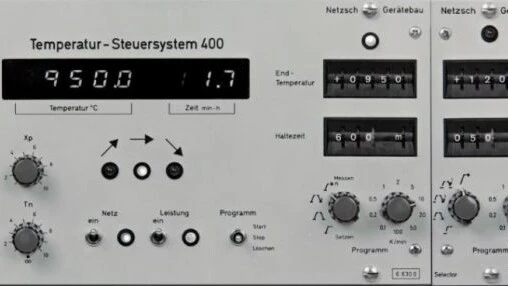
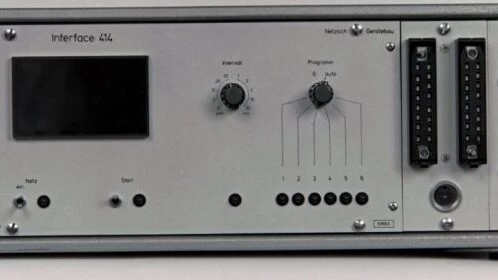
1973: Sprzężenie spektrometrów masowych (MS)
Grupa NETZSCH, składająca się z poszczególnych niemieckich spółek Gebrüder NETZSCH-Anlagenbau, NETZSCH-Mohnopumpen, NETZSCH-Feinmahltechnik, NETZSCH-Newamatik, NETZSCH-Gerätebau i NETZSCH-Vertriebsgesellschaft, była w dobrym nastroju i świętowała swoje 100-lecie 1 lipca 1973 r. wraz z zagranicznymi spółkami zależnymi na "niezwykle bogatym przyjęciu firmowym" w Selb. (Zacząłem pracować dla NETZSCH-Gerätebau 100 lat i jeden dzień po założeniu NETZSCH; tj. dokładnie dzień po obchodach 100-lecia. Do dziś nie potrafię odpowiedzieć na pytanie, dlaczego mnie tam nie było...)
Już na początku lat 70. firma Balzers z Liechtensteinu cieszyła się dobrą reputacją dzięki swoim kwadrupolowym spektrometrom mas (QMS) do kontroli procesów. NETZSCH-Zainteresowanie Gerätebau współpracą z Balzers w celu opracowania sprzęgła MS dla STA 429 było bardzo duże, a Balzers z kolei był pod wrażeniem otwartości umysłu na NETZSCH w zakresie optymalizacji zintegrowanych systemów wlotu gazu. W ten sposób w dziale technicznym Gerharda Bräuera i jego zespołu skonstruowano system wlotu gazu składający się z platynowej kapilary i platynowej kryzy.
Zaowocowało to sprzężeniem spektrometru masowego, które nadal działa w temperaturach znacznie przekraczających 1000°C oraz mechanicznie precyzyjnym komponentem modułowym do instalacji w piecu STA 429 o temperaturze 1600°C.


1974: Wprowadzenie pierwszego i unikalnego połączenia spektrometru masowego NETZSCH-Balzers
Wylot nowego interfejsu sprzęgającego stanowi dwustopniowa obrotowa pompa próżniowa w pierwszym etapie (kapilara Pt). Wysoki poziom próżni niezbędny do opróżniania kryzy Pt, źródła jonów i kwadrupolowego filtra masowego jest zapewniany przez pompę dyfuzyjną z niskofragmentowym (w odniesieniu do widma tła MS) smarem eteru polifenylowego jako pompą medium.
Piec, układ sprzęgający i pompa wysokopróżniowa są zamontowane na pionowym "podnośniku", aby umożliwić swobodny dostęp do nośnika próbki w celu wymiany próbki w STA. Jest nawet miejsce na dodatkowe piece do "normalnych" testów STA.
Sprzęt był używany na Uniwersytecie w Konstancji do badania krzemianów i był konsekwentnie, starannie i niezawodnie konserwowany przez dział serwisowy NETZSCH przez wiele dziesięcioleci.
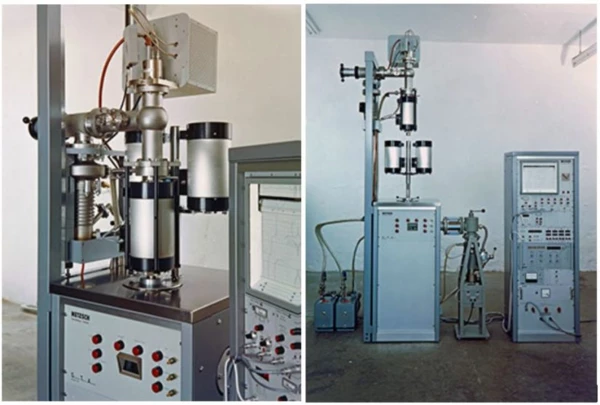
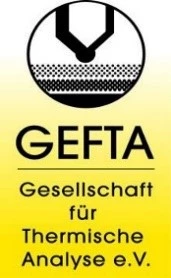
rok 1974 oznacza również założenie stowarzyszenia non-profit zajmującego się analizą termiczną w obszarze niemieckojęzycznym, GEFTA. Między innymi dwa nazwiska odegrały decydującą rolę w założeniu nowego stowarzyszenia: Prof.-Dr. Ing. Hans Lehmann z Clausthal-Zellerfeld i dr Wolf-Dieter Emmerich z NETZSCH w Selb, którzy przekonali kilku pracowników NETZSCH, aby również zostali członkami-założycielami GEFTA; pozwoliło to stowarzyszeniu rozpocząć działalność z około 20 członkami.
Uniwersytet w Konstancji został wybrany na miejscetrzeciego dorocznego spotkania GEFTA już w 1976 roku, co było wyrazem uznania dla działalności w dziedzinie analizy termicznej na miejscu. GEFTA była już w stanie zwiększyć liczbę swoich członków do ponad 50 osób i stała się integrującym stowarzyszeniem aktywnych analityków termicznych i badałaarcją równolegle z krajowymi organizacjami z sąsiednich krajów.
1975: Początek tradycji seminariów na temat sprzęgania systemów analizy gazów
largePod koniec 1975 r. to sprzęgło spektrometru masowego z platynową kapilarą i kryzą zostało zaprezentowane międzynarodowej grupie zainteresowanych stron przy okazji seminarium zatytułowanego "NETZSCH-Balzers-MTA High-Temperature Coupling Systems" (MTA oznacza spektrometryczną analizę termiczną, skrót dziś już nieużywany). Wraz z tym, NETZSCH zrealizował również znacznie prostsze sprzęgło spektrometru masowego ze stalową kapilarą i platynową kryzą, oferowane później przez Balzers jako oddzielny moduł wlotu gazu lub w kompaktowym rozwiązaniu z Thermostar. W tym przypadku pobieranie próbek gazu odbywało się na wylocie gazu odpowiedniego pieca, umożliwiając sprzężenie ze wszystkimi gazoszczelnymi instrumentami, takimi jak DTA, TGA, STA i dylatometry. Unikalną zaletą w porównaniu z ofertą konkurencji było kompleksowe i regulowane podgrzewanie do 200°C wylotu gazu z pieca.
Jakie były więc kolejne kroki związane z wysokotemperaturowym systemem sprzęgającym?
Znalezione rozwiązanie techniczne, praktyczne wykonanie i czułość wykrywania spektrometru masowego w zakresie ppm w połączeniu z analizą termiczną wydawały się więcej niż wystarczające dla wszystkich obaw i zastosowań. Drobne niedociągnięcia w projekcie eksperymentalnym i ocenie były spowodowane powolną rejestracją za pomocą wielokanałowych drukarek punktowych, stosunkowo małą prędkością skanowania spektrometru masowego i czasami zbyt dużą liczbą pików w widmie tła. Tak, czasami zdarzały się również atomy, cząsteczki i związki, które po prostu nie znalazły drogi przez kapilarę i kryzę, które zostały zniszczone termicznie po drodze lub których nie można było wiarygodnie określić na podstawie zarejestrowanych pików MS. Czasami trzeba było rozwinąć długie na metr wstęgi papieru rejestrującego, aby znaleźć "jedno" odpowiednie odchylenie sygnału MS.
Dyskusje z potencjalnymi zainteresowanymi zintegrowanym sprzężeniem MS-STA doprowadziły do opracowania nowych materiałów w układzie wlotu gazu w piecu STA. W przypadku tych zastosowań platyna nie wchodziła w rachubę ze względu na jej katalityczny wpływ na próbki i produkty rozkładu, które miały być wykrywane. Zastosowano spiekane rurki korundowe o wysokiej czystości selected, które miały mieć dobrą odporność w zakresie temperatur roboczych. We współpracy z producentami ceramiki i wyspecjalizowanymi instytutami rozwiązano stojące przed nami wyzwania, takie jak wiercenie otworów small laserem (kryz) w dnie rur i lutowanie ich do metalowych kołnierzy. Stworzono system podwójnej kryzy.

Co ciekawe, to właśnie badaniaarch nad właściwościami w stanie stałym i pojawiającą się ceramiką techniczną, z problemami takimi jak wypalanie spoiw organicznych i lotność nieorganicznych środków spiekających, doprowadziły do tego podwójnego rozwiązania.
1978: Dostawy modelu STA 429 z systemem podwójnej kryzy
Max Planck Institute for Solid State Research, Stuttgart, Niemcy, był pierwszym klientem naszego sprzęgła z podwójną kryzą.
Kolejny obszar badańarch, który stał się przedmiotem zainteresowania, dotyczył "bezpiecznego" usuwania odpadów radioaktywnych w kontekście badań nuklearnycharch. Jülich Research Center (wówczas jeszcze Jülich Nuclear Research Facility) zakupiło STA 429 z systemem podwójnej kryzy w celu research uwalniania gazu ze zeszklonych odpadów. Prof. dr Reinhard Odoj (1973 - 2009 dyrektor ds. badań bezpieczeństwaarch i technologii reaktorów w Jülich Research Center) i jego współpracownik wnieśli znaczący wkład w optymalizację wysokotemperaturowego sprzęgła MS dla tego obszaru zastosowań. Jednym z celów był system wlotu gazu, który pozwoliłby na niezawodne wykrywanie oparów metali, takich jak cez, selen, tellur, tlenki rutenu i srebro (jako substancje referencyjne o podobnej lotności do odpadów radioaktywnych). Wysokotemperaturowe sprzężenie MS zostało znacząco zoptymalizowane pod kątem tego zastosowania we współpracy z profesorami z ośrodka badawczegoarch. Badania doprowadziły do rozprawy doktorskiej z opisem wielu poszczególnych etapów aż do "sprzęgaczaskimmer ", wykonanego z metalu o znacznie zmniejszonych odległościach między próbką, wlotem gazu i źródłem jonów MS, a wszystko to z odpowiednio krótkim piecem.
Przeniesienie tego "instytutowego rozwiązania" do komercyjnie produkowanego systemu sprzęgającego skimmer na stronie NETZSCH było bardzo skomplikowane. Przeprojektowanie pieca i znalezieniearch optymalnych materiałów Skimmer dla różnych temperatur roboczych i zakresów to tylko niektóre z kluczowych punktów. Skimmerwykonano z metalu odpornego na wysokie temperatury, szkła kwarcowego, tlenku glinu i węgla szklistego. Tlenek glinu i węgiel szklisty okazały się najbardziej wszechstronne i praktyczne w różnych zakresach temperatur i atmosferach próbek.
Na rozwój przyrządów korzystnie wpłynął fakt, że asortyment pieców na stronie NETZSCH rozszerzył się z zakresu niskich temperatur od -180°C do 2400°C, do wytwarzania próżni zaczęto stosować niezawodne pompy turbomolekularne, a także zaprojektowano kompaktowe urządzenia podnoszące.
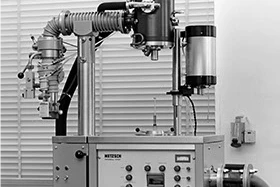
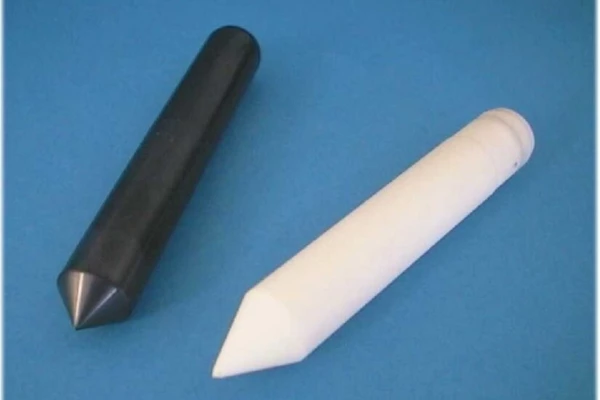
1985: Wprowadzenie pierwszego na świecie i unikalnego złącza wysokotemperaturowego z systemem wlotu gazu Skimmer
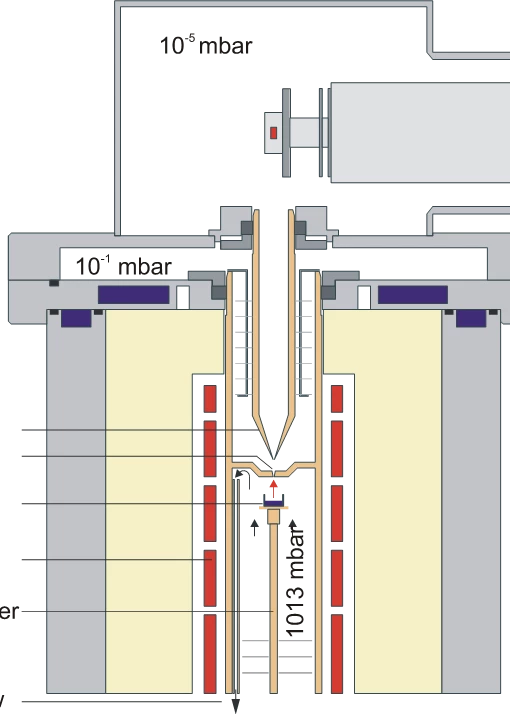
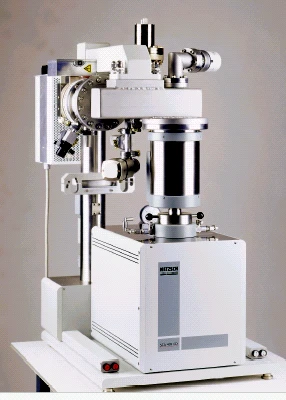
Równolegle do dalszego rozwoju sprzęgła kryzowego do sprzęgła Skimmer opisanego powyżej, nowe centrum doskonałości w zakresie badań środowiska, paliw i energiiarch zostało opracowane na (kompleksowym) Uniwersytecie w Paderborn, na Wydziale Chemii prowadzonym przez prof. dr Antoniusa Kettrupa z podwójnym sprzęgłem kryzowym STA 429 MS. Bardzo owocna współpraca z prof. dr Antoniusem Kettrupem i jego zespołem zaowocowała również ulepszeniami instrumentalnymi (automatyczna kontrola ciśnienia w systemie wlotowym) i przeprojektowaniem instrumentów po przeniesieniu zespołu research do Neuherberg koło Monachium do ówczesnego Centrum Badań Środowiska i Zdrowia GASS Research. Do badań środowiskowycharch (np. utylizacja odpadów, skażone gleby), large=sample STA (objętość próbki do 170 cm³) z możliwością sprzężenia spektrometrów masowych, spektrometrów FT-IR i instrumentów GC-MS został zbudowany przez NETZSCH w ramach bawarskiego finansowania research.
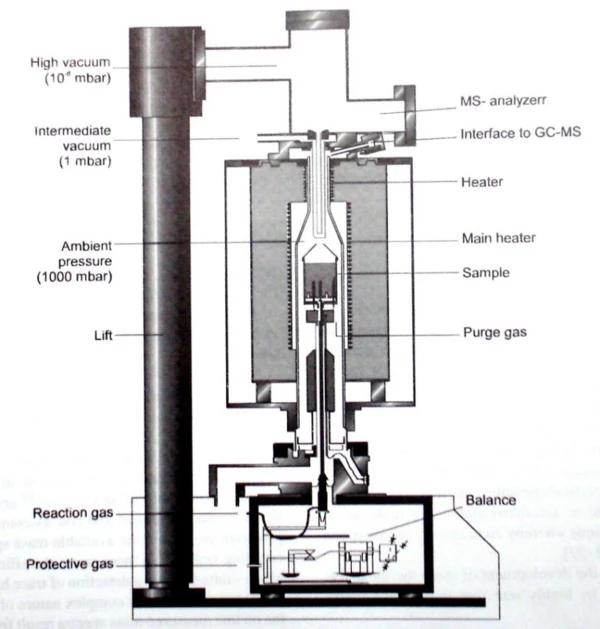
Ale co będzie dalej? Jakie nowe wydarzenia nastąpią? Więcej informacji w nadchodzących tygodniach..